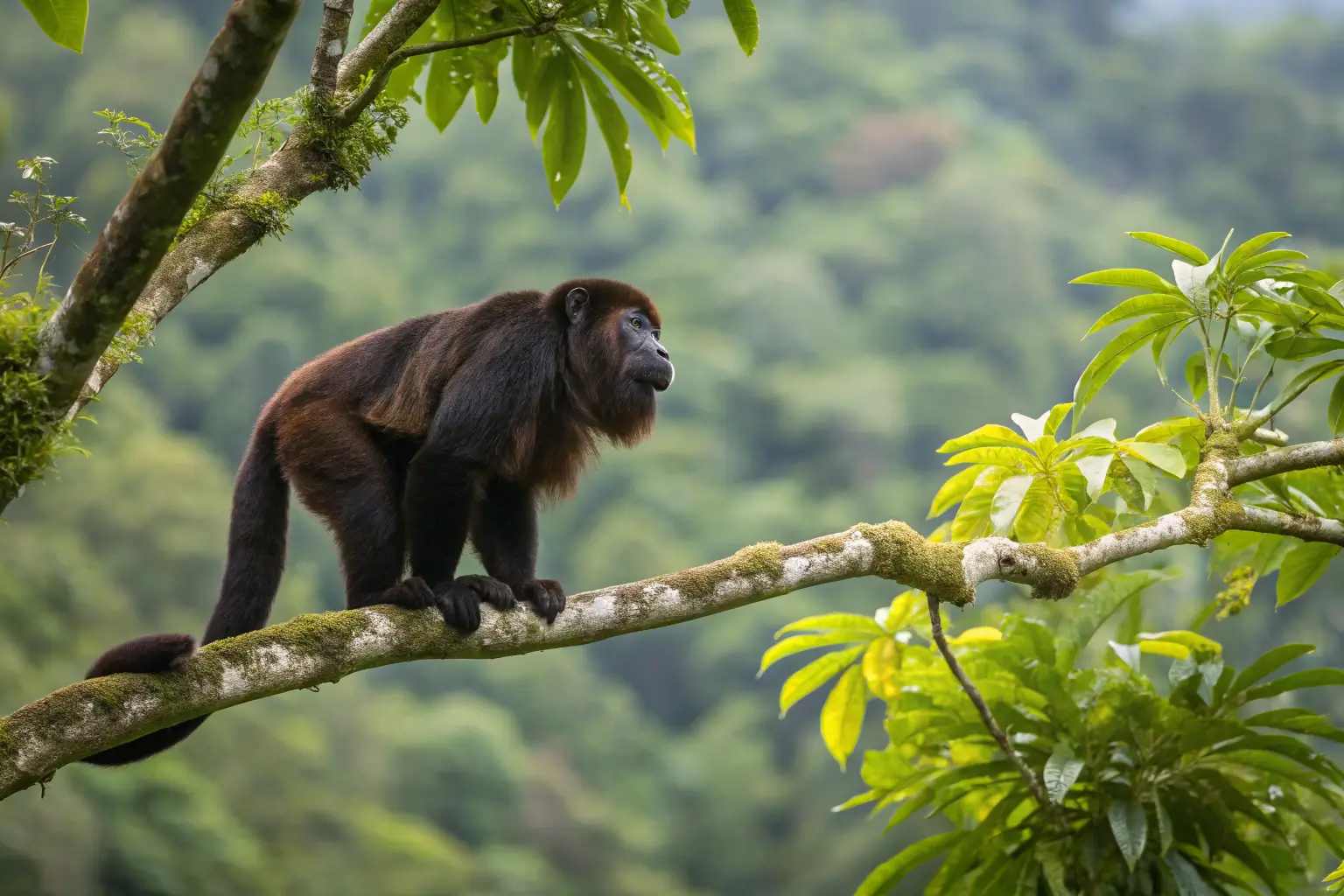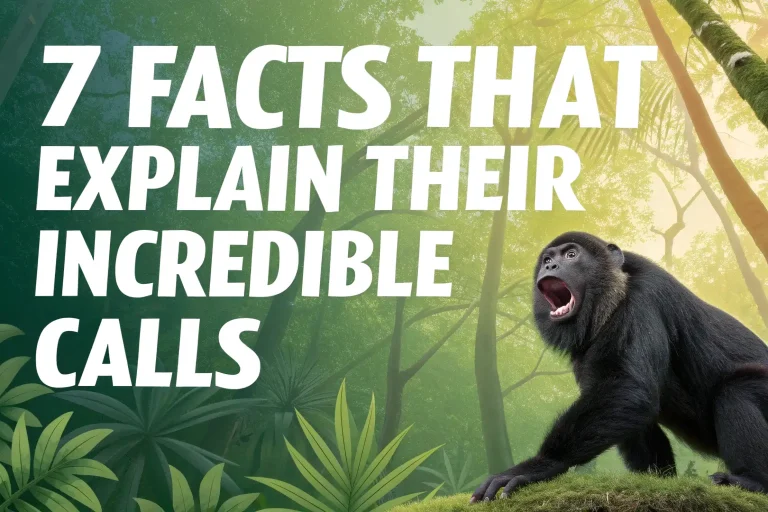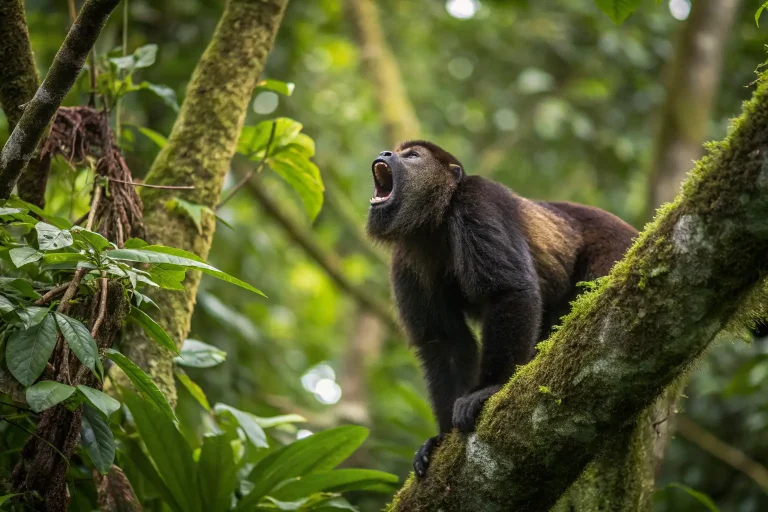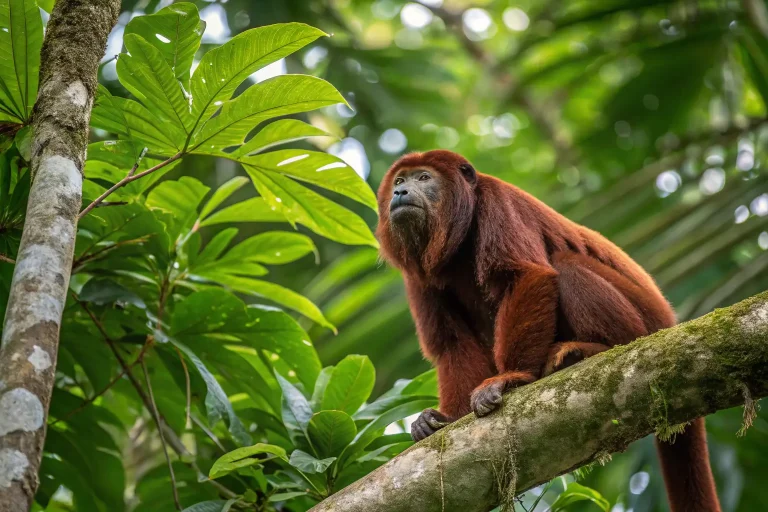Howler Monkey Costa Rica: 7 Reasons They’re a Must-See!
Trekking through Costa Rica’s lush rainforests, you’ll likely hear them before you see them. The deep, guttural roar that echoes through the canopy isn’t from a jaguar or some mythical beast – it’s the unmistakable call of the howler monkey, Costa Rica’s vocal jungle ambassador. These fascinating primates have earned their reputation as one of the country’s most iconic wildlife attractions, drawing nature enthusiasts from across the globe to witness their remarkable behaviors and distinctive traits firsthand.
The howler monkey Costa Rica experience ranks among the top wildlife encounters in Central America, offering visitors a genuine glimpse into the complex social structures and behaviors of these remarkable creatures. Whether you’re planning your first Costa Rican adventure or returning for more tropical exploration, understanding why these primates deserve a spot on your must-see list will enhance your appreciation of these extraordinary animals.
Introduction
The howler monkey holds a special place in Costa Rica’s rich biodiversity tapestry. As the largest of the New World monkeys, these remarkable creatures serve as flagship species for conservation efforts throughout the country’s protected areas. Their presence indicates healthy forest ecosystems, making them not just fascinating animals to observe but essential components of environmental health monitoring.
Learning about howler monkeys provides valuable insights into primate evolution, tropical ecology, and the delicate balance of rainforest ecosystems. For visitors to Costa Rica, understanding these monkeys enhances wildlife viewing experiences and creates meaningful connections to conservation initiatives protecting these intelligent creatures.
Did you know that despite their intimidating roars, howler monkeys are among the most peaceful primates? Their famous calls can travel up to three miles through dense jungle – an impressive feat for an animal weighing only 15-22 pounds! This remarkable vocalization, which ranks among the loudest of any land animal, serves as their primary defense mechanism rather than physical confrontation.
Species Overview
Scientific Name
The howler monkeys of Costa Rica belong to the genus Alouatta. The most common species encountered in Costa Rica is the mantled howler monkey (Alouatta palliata), though the black howler (Alouatta pigra) can occasionally be spotted in northern regions. These primates belong to the family Atelidae, which includes other New World monkeys like spider monkeys and woolly monkeys.
Physical Characteristics
Adult howler monkeys in Costa Rica typically weigh between 10-22 pounds (4.5-10 kg), with males generally larger than females. Their body length ranges from 22-36 inches (56-92 cm), not including their prehensile tail, which adds another 23-36 inches (58-91 cm) and functions as a fifth limb for gripping branches.
The mantled howler displays distinctive black fur with golden-brown or blonde sides, creating a “mantled” appearance that gives the species its name. Their faces are bare with prominent, expressive eyes and a well-developed jaw structure that houses their specialized vocal apparatus – the enlarged hyoid bone that enables their characteristic howling. The most striking physical feature is their elongated lower jaw, which accommodates their uniquely adapted vocal anatomy.
Subspecies
Within Costa Rica, researchers recognize several subspecies of the mantled howler, including:
- Alouatta palliata palliata: The most widespread subspecies found throughout much of the country
- Alouatta palliata aequatorialis: Occasionally spotted in southwestern regions near the Panamanian border
These subspecies show subtle variations in coloration and size, though casual observers might not readily distinguish between them during typical wildlife viewing experiences.
Habitat and Distribution
Natural Habitat
The howler monkey Costa Rica population thrives primarily in tropical rainforests, though these adaptable primates also inhabit cloud forests, dry forests, and mangrove swamps. They prefer the upper canopy layers where they find abundant foliage for feeding and protection from ground predators. Unlike many rainforest species, howlers can survive in relatively disturbed or fragmented habitats, provided sufficient tree cover remains for their arboreal lifestyle.
These monkeys require territories with diverse tree species that offer year-round food sources. Mature forests with tall, interconnected canopies provide ideal habitats, allowing howlers to move freely without descending to the ground – a behavior they generally avoid except in rare circumstances.
Geographic Range
In Costa Rica, howler monkeys enjoy widespread distribution throughput the country. Visitors can encounter them in virtually every protected area containing forested habitat, from the northern regions near Nicaragua to the southern zones bordering Panama. Prime howler monkey viewing areas include:
- Manuel Antonio National Park (Central Pacific)
- Corcovado National Park (Osa Peninsula)
- Monteverde Cloud Forest Reserve (Central Highlands)
- Tortuguero National Park (Caribbean Coast)
- Santa Rosa National Park (Guanacaste Province)
Costa Rica serves as a critical habitat within the broader geographic range of howler monkeys, which extend from southern Mexico through Central America and into parts of South America, including Colombia, Venezuela, and Brazil.
Adaptations
Howler monkeys have evolved several remarkable adaptations for their arboreal lifestyle in Costa Rica’s forests:
Their prehensile tails function as a fifth limb, allowing them to hang securely while feeding or resting, and providing stability during movement through the canopy. The tail’s underside lacks fur near the tip, featuring tactile pads similar to fingerprints that enhance grip sensitivity.
The distinctive howling that gives these monkeys their name represents an energy-efficient territorial defense adaptation. Rather than physically patrolling extensive territories, howlers announce their presence vocally, conserving precious energy in their leaf-based, low-calorie diet ecosystem.
Their digestive system has specialized adaptations for processing tough leaf material, including an enlarged cecum where bacterial fermentation breaks down cellulose. This adaptation allows howlers to survive on leaves during seasonal food scarcity when fruits become limited.
Diet and Feeding Habits
What It Eats
Howler monkeys in Costa Rica maintain a primarily folivorous (leaf-eating) diet, though with significant seasonal variation. Their typical diet consists of:
- Young leaves (40-60% of diet)
- Mature leaves (15-30%)
- Fruits (15-30%)
- Flowers and buds (5-10%)
- Occasional bark, stems, and insect larvae
Unlike many primates that rely heavily on fruit, howlers’ specialized digestive system allows them to process nutritionally poor, high-fiber leaves that other animals cannot efficiently digest. This adaptation reduces competition for food resources but requires careful energy conservation due to the relatively low caloric value of their primary food source.
Hunting or Foraging Behavior
Howler monkeys employ a methodical foraging strategy, moving deliberately through their territory to maximize energy efficiency. Their typical day includes:
- Early morning feeding (6:00-9:00 AM)
- Midday rest and digestion
- Afternoon feeding (3:00-6:00 PM)
They select feeding sites based on nutritional value, often targeting young leaves that contain fewer toxic compounds and more protein than mature foliage. During fruit abundance, howlers may concentrate feeding activities around productive trees, carefully selecting ripened fruit for its higher sugar content and digestibility.
Interestingly, Costa Rican howlers rarely drink water directly, instead obtaining most moisture from their food. During dry seasons, they may lick dew from leaves in early morning hours or increase consumption of succulent vegetation to maintain hydration.
Dietary Needs
The howler’s specialized diet presents unique nutritional challenges. Their leaf-heavy consumption provides adequate protein but limited easily digestible carbohydrates. To meet energy requirements, howlers have evolved several strategies:
- Selective feeding on higher-protein young leaves
- Strategic fruit consumption when seasonally available
- Extensive rest periods to conserve energy (howlers sleep or rest 15-19 hours daily)
- Relatively slow movement compared to other primates
- Maintaining small group sizes to reduce feeding competition
These dietary adaptations explain many behavioral traits visitors observe in Costa Rican howler monkeys, including their seemingly lethargic movement and extensive periods of apparent inactivity.
Behavior and Social Structure

Social Behavior
Howler monkey Costa Rica populations typically organize into groups of 10-20 individuals, though group size varies based on habitat quality and resource availability. These groups display a hierarchical social structure with the following characteristics:
- Male dominance hierarchy determining breeding privileges
- Female relationships often based on kinship
- Relatively low intra-group aggression compared to many primates
- Territorial defense primarily through vocalization rather than physical confrontation
- Occasional group fission when population exceeds optimal size
Unlike many primate species, howler monkeys demonstrate relatively relaxed social dynamics with minimal grooming behaviors. Their energy conservation strategy discourages excessive movement or social interaction, resulting in what appears to visitors as a calm, deliberate lifestyle punctuated by dramatic vocal displays.
Communication
The hallmark communication method of howler monkeys—their eponymous howling—represents one of nature’s most impressive vocal demonstrations. These calls serve multiple purposes:
- Territorial announcement and defense
- Group coordination during movement
- Male status signaling and intimidation
- Response to potential threats
- Weather-related calls (particularly before rainfall)
Beyond vocalization, howler monkeys utilize subtle body language including:
- Tail postures indicating emotional states
- Branch shaking during territorial displays
- Facial expressions communicating aggression or submission
- Scent marking from specialized glands
For visitors to Costa Rica, witnessing a howling display—typically most active at dawn and dusk—provides an unforgettable wildlife experience that echoes the primeval nature of rainforest ecosystems.
Mating and Reproduction
Howler monkeys follow a polygynous mating system where dominant males typically monopolize breeding opportunities within the group. Their reproductive patterns include:
- No distinct breeding season, though slight birth peaks during wetter months
- 6-month gestation period
- Single offspring (twins are extremely rare)
- 18-24 month interval between births
- Sexual maturity at 3-4 years for females, 4-5 for males
- Infant care primarily by mothers, with limited paternal involvement
Young howlers display distinctive golden-yellow fur that darkens with age, making juveniles easily identifiable during wildlife viewing. This coloration may reduce infanticide risk by signaling the infant’s age to new males entering the group.
Conservation Status
Endangerment Level
According to the International Union for Conservation of Nature (IUCN), the mantled howler monkey (Alouatta palliata) currently holds “Least Concern” status globally. However, this broad classification masks significant regional population declines, including in parts of Costa Rica where localized threats have reduced numbers in unprotected areas.
While Costa Rica’s extensive protected area system has maintained relatively healthy howler populations compared to neighboring countries, monitoring indicates concerning trends in fragments outside conservation zones. The country’s howler populations face increasing pressure from habitat changes and human encroachment despite their adaptability.
Threats
Howler monkey Costa Rica populations face several significant threats:
Habitat Fragmentation: Conversion of continuous forest to agricultural lands creates isolated patches that restrict genetic flow and limit food resources. Even when trees remain, gaps exceeding 100 meters create effective barriers to howler movement.
Infrastructure Development: Road construction, hydroelectric projects, and tourism facilities increasingly intrude on howler habitat, particularly in coastal areas experiencing rapid development.
Disease: Periodic yellow fever outbreaks have caused significant mortality in Costa Rican howler populations. Human proximity increases disease transmission risk, with recent concerns about potential zoonotic disease exchanges.
Climate Change: Altered rainfall patterns affect food availability and phenology (timing of leaf and fruit production), potentially creating resource gaps during critical periods.
Electrocution: Contact with uninsulated power lines causes substantial howler mortality in developed areas, particularly affecting troops that adapt to suburban environments.
Conservation Efforts
Costa Rica has implemented several successful conservation initiatives benefiting howler monkeys:
Protected Area System: Approximately 25% of Costa Rica’s territory enjoys formal protection, creating critical habitat refuges. Key parks like Corcovado, Santa Rosa, and Manuel Antonio maintain significant howler populations.
Biological Corridors: The Mesoamerican Biological Corridor project works to reconnect fragmented forests, allowing howler population connectivity and genetic exchange.
Wildlife Bridges: Strategic installation of canopy bridges across roads has reduced isolation in some fragmented habitats, with documented howler use in areas like Manuel Antonio.
Community Ecotourism: Local initiatives that generate income through wildlife viewing create economic incentives for habitat protection while raising awareness about howler conservation.
Rehabilitation Programs: Several Costa Rican wildlife centers rehabilitate injured or orphaned howlers, including Kids Saving the Rainforest and Jaguar Rescue Center.
Interesting Facts
The howler monkey Costa Rica relationship extends beyond ecological importance into fascinating realms of biology and behavior:
Despite their fearsome roars, howler monkeys rank among the least aggressive primates, preferring vocal intimidation over physical confrontation.
Their specially adapted hyoid bone (found in the throat) is enlarged and hollow, creating a resonance chamber that amplifies vocalizations to reach an astonishing 140 decibels – comparable to a jet engine at takeoff.
Howlers possess trichromatic color vision similar to humans, an adaptation believed to help identify nutritious young leaves by their reddish coloration.
They play crucial roles in forest regeneration by dispersing seeds of many plant species through their digestive systems, contributing to tropical forest diversity.
Unlike most mammals, howler monkeys lack the gene for digesting dietary ethanol, meaning they cannot process alcohol from fermented fruits – a possible evolutionary response to their leaf-heavy diet.
Howlers practice energy conservation so effectively that they have the slowest metabolic rate of any non-hibernating mammal their size.
Their prehensile tails are so strong they can support the monkey’s entire body weight, even while sleeping, and contain specialized tactile nerve endings that function similar to fingertips.
Tips for Observing Howler Monkeys in Costa Rica
While howler monkeys aren’t kept as pets (nor should they be), many travelers hope to observe these fascinating primates during Costa Rican visits. For optimal viewing experiences:
Best Viewing Locations:
- Manuel Antonio National Park offers almost guaranteed sightings along established trails
- Monteverde Cloud Forest Reserve provides canopy-level viewing opportunities
- Corcovado National Park contains Costa Rica’s densest howler populations in a pristine setting
Optimal Timing:
- Early morning (5:30-8:00 AM) and late afternoon (4:00-6:00 PM) yield highest activity levels
- Dawn chorus howling offers spectacular audio experiences, typically beginning 30-45 minutes before sunrise
- Wet season (May-November) often increases visibility as howlers move more frequently seeking diverse food sources
Viewing Ethics:
- Maintain minimum 10-meter distance to prevent stress to the monkeys
- Never feed wild howlers – human food causes digestive problems and alters natural behaviors
- Keep voices low to avoid disrupting natural activities or triggering defensive howling
- Use binoculars rather than approaching closer for better detail observation
Photography Tips:
- 300mm+ telephoto lenses provide detail without disturbance
- Morning side-lighting highlights their distinctive silhouettes
- Patience yields behavioral sequences more valuable than simple presence documentation
- Consider recording audio alongside images to capture the complete sensory experience
Role in the Ecosystem
Ecological Importance
Howler monkeys function as keystone species in Costa Rican forests through several crucial ecological roles:
Seed Dispersal: As frugivores during certain seasons, howlers consume fruits and deposit seeds far from parent trees, enhancing forest diversity and regeneration. Their relatively large gut allows for transport of bigger seeds than many other dispersers can handle.
Canopy Pruning: Their leaf consumption stimulates new growth in browsed trees, creating more productive canopy through strategic trimming. This “herbivore pruning effect” increases overall forest productivity.
Nutrient Cycling: Howler waste material provides concentrated nutrient deposits that benefit understory plants, creating “hotspots” of enhanced growth beneath frequently used trees.
Food Web Support: As mid-sized mammals, howlers serve as occasional prey for large predators like harpy eagles and jaguars, contributing to complex rainforest food webs.
Forest Health Indicators: Their population dynamics reflect overall ecosystem health, making them valuable bioindicators for conservation monitoring. Changes in group size, composition, or behavior often signal broader ecological shifts.
Impact of Decline
The potential decline of howler monkey populations would trigger several ecological consequences:
- Reduced seed dispersal affecting forest regeneration, particularly for plant species with larger seeds
- Altered vegetation composition favoring wind-dispersed species over animal-dispersed varieties
- Changed competitive dynamics among remaining primate species
- Decreased rainforest resilience during recovery from disturbances
- Potential overgrowth of certain tree species previously controlled by browsing pressure
- Loss of significant ecotourism value that helps justify forest protection
Costa Rica’s conservation efforts recognize these interconnections, positioning howler protection within broader ecosystem management strategies rather than treating them as isolated species.
Conclusion
The howler monkey Costa Rica experience represents far more than a simple wildlife sighting—it offers a window into the complex relationships that define tropical forest ecosystems. These remarkable primates, with their thunderous calls echoing through misty canopies, embody the wild spirit that draws so many visitors to Costa Rica’s forests each year.
From their specialized adaptations for leaf consumption to their energy-efficient lifestyle and complex social structures, howler monkeys demonstrate evolutionary ingenuity that has allowed them to thrive in Central American forests for millions of years. Their continued presence in Costa Rica’s protected areas stands as testimony to the country’s conservation commitment.
For travelers fortunate enough to witness these charismatic primates in their natural habitat, the experience creates lasting connections to rainforest conservation. By understanding howler ecology and appreciating their ecological roles, visitors develop deeper appreciation for the intricate balance that sustains tropical biodiversity. The next time you find yourself beneath Costa Rica’s verdant canopy and hear that unmistakable roar rolling across the treetops, remember you’re experiencing one of nature’s most impressive vocal performances—and an essential voice of the living forest.
Frequently Asked Questions
Why are howler monkeys so loud?
Howler monkeys evolved their exceptional vocal abilities primarily as an energy-saving territorial defense mechanism. Rather than physically patrolling large territories (which would require considerable energy for leaf-eating primates), they announce their presence through long-distance calls. The specialized enlarged hyoid bone in their throat creates a natural amplification chamber, allowing sounds to travel up to three miles through dense forest. This adaptation lets groups space themselves appropriately without direct confrontation.
What is the best time of day to see howler monkeys in Costa Rica?
Early morning (5:30-8:00 AM) offers the highest probability for howler monkey sightings and activity. Dawn triggers their characteristic “morning chorus” of howls and coincides with their first active feeding period. Late afternoon (4:00-6:00 PM) provides another active window before they settle into sleeping trees. During midday hours, howlers typically rest and digest, making them less visible and active.
Are howler monkeys dangerous to humans?
Howler monkeys pose virtually no danger to humans. Despite their intimidating vocalizations, they’re among the least aggressive primates, typically retreating rather than confronting perceived threats. They rarely descend to ground level where human interaction would occur. Unlike some monkey species, howlers don’t typically steal food or approach humans closely. Their herbivorous diet and naturally cautious temperament make negative interactions extremely rare.
How can I tell the difference between howler monkeys and other Costa Rican monkeys?
Costa Rica hosts four monkey species, each with distinctive characteristics:
- Howler monkeys: Largest size, black with brownish sides, bearded appearance, move slowly, loud roaring calls
- Spider monkeys: Long, gangly limbs, prehensile tail often held in hook position, more active movement, no visible thumb
- Capuchin monkeys: Medium-sized with distinctive black “cap” on white face, more ground-foraging, highly curious behavior
- Squirrel monkeys: Smallest species, golden-orange back with white face mask, travel in large groups, rapid movements
Why do howler monkeys howl more before rain?
The increased howling activity before rainfall likely serves several purposes. Acoustically, sound travels farther in humid air with higher atmospheric pressure that often precedes storms. This creates optimal conditions for territorial communication. Additionally, howlers typically increase feeding activity before storms (when they’ll later shelter), and howling helps coordinate group movement. Some researchers also speculate the behavior might relate to decreasing barometric pressure affecting their sinuses or ear canals.
Can I see howler monkeys year-round in Costa Rica?
Yes, howler monkeys remain active year-round in Costa Rica without hibernation or significant seasonal migrations. However, viewing experiences may vary between dry season (December-April) and wet season (May-November). During drier months, reduced foliage can improve visibility, while wetter periods often increase feeding activity as new leaf growth peaks. Unlike some wildlife species that become scarce during certain seasons, howlers maintain consistent presence throughout the year in appropriate habitats.
How can I support howler monkey conservation in Costa Rica?
Effective ways to support howler conservation include:
- Visiting protected areas where entrance fees directly fund conservation
- Using guides from local communities who monitor and protect monkey populations
- Supporting organizations like Kids Saving the Rainforest or Jaguar Rescue Center that rehabilitate injured monkeys
- Choosing accommodations with strong sustainability credentials that preserve forest habitat
- Reporting any wildlife harassment or illegal activity to park authorities
- Sharing knowledge about howler importance with other travelers to expand conservation awareness





